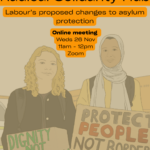A guest post by Aliyah Aruj and Courtney Shaw. The authors are third year Law (Hons) LLB students at the University of Huddersfield, studying an elective in Immigration and Asylum Law.

Seeking asylum in the UK as a woman can result in legal and practical struggles to establish the need for protection as a refugee. This blog post will explain the key struggles faced and how the Home Office have applied assistance over the years to female immigrants, whilst also discussing the problem areas that still remain today.
Despite the recognition of gender-based claims in the Refugee Qualification Directive, women are subjected to great difficulty in obtaining refugee status in the UK. Ranging from the lack of information made available to female applicants to the credibility of applicants doubted because of the failure of the Home Office to understand the circumstances of applicants, it is evident the insensitive procure currently in practice limits the success of female applicants, ultimately hindering its ability to protect women.
Legal Gains
The Refugee Convention 1951 makes no mention of the subject of gender. However, there have been significant legal gains in the recognition of gender-based persecution.
Article 10(1)(d) of the Refugee Qualification Directive describes members of a particular social group to all share an immutable characteristic, which cannot be changed, that is so essential to their personal identity that they should not be forced to abandon it. This has been extended to recognise refugee claims made on the basis of gender.
In the case of NS Afghanistan (2004), the appellant was an Afghanistan citizen, who was a member of a particular social group of unmarried Afghan women, who all shared the same history of being sexual assault victims, and with female children. The appellant was found to be at real risk of persecution by non-state agents if she were to return to her country of nationality due to the past events of ill-treatment (motivated by the political opinions of her persecutors) and her fear of future ill-treatment.
The UK Immigration Justice Watch explained how in the appellants case, The Upper Tribunal had found that due to her immutable characteristic of being a woman, the appellant was shown to be a member of a particular social group. The Appellant was able to illustrate a causal nexus between her status as a lone woman and her ill-treatment. Overall, the appellant was able to demonstrate that women in her country of nationality were exposed to discrimination sufficiently serious to meet the threshold of persecution. This finding was made possible by a similar finding by the House of Lords in an earlier case regarding women from Pakistan: Shah & Islam (1999) UKHL 20.
Since the case of Shah and Islam, some improvements have been made in context to the recognition of forms of abuse faced by women who are claiming asylum in the UK. The ASAP Project highlights how in more recent times, the Home Office publish ‘gender- disaggregated data’ about the patterns and numbers of women entering UK asylum processes along with the outcomes of their applications and appeals. This therefore shows how more recently, women who have been subject to past persecution of sexual violence are now being taken into closer consideration by the Home Office when entering applications for asylum in the UK.
What are the main issues for women seeking asylum?
Despite the gains associated with the legal recognition of gender based violence and discrimination as a form of persecution which the Refugee Convention can and will protect women from, “Women are still finding the system hostile and unresponsive to their needs”.
Jade Freeman noted how in asylum proceedings, married couples are often forced to claim asylum together as opposed to applying independently, as it allows for the male to be the primary claimant in the procedure and the woman to be labelled as a dependant to the male, which would not be the case if she had applied separate from her husband. Freeman argues that this may cause negative consequences for the woman, as this forces her to be a reliant on the male for any further legal status she may face. This is particularly catastrophic if the woman is in an abusive relationship, and may then not be able to have the right to have a free life away from the violent relationship, as this could consequently lose her right to remain in the host country.
Many applicants are unaware of the ability to file for individual applications for women and children. Others often have no other opportunity to understand the rights available to them apart from the interview process. The success of female applicants would be greatly improved by informing applicants of their individual rights to an asylum claim, within the reception centres and interviews.
Even when women are registered as asylum applicants in their own right, they also face barriers in gaining refugee status as their applications as often viewed as less credible. The 2008 Independent Asylum Commission found there was a ‘culture of disbelief’ surrounding women’s stories and a severe lack of understanding towards gender specific struggles, thus leading to unjust decisions. As the assessment of credibility forms the ‘core of the decision to refuse’, women are often found to not be taken seriously by the Home Office, despite their claims.
Many women also may find their claims are refused due to difficulties in disclosing the relevant information for their claim. In the 2012 Asylum Aid report, a female survivor of trafficking reported she was expected to provide immediate details of sex work in the initial interview, with strangers listening to her and in the presence of her own children.
Female asylum applicants are often victims of traumatic experiences, which may affect their ability to give accurate accounts of the events. Some women may also be impacted by stigmas and shame surrounding their experiences of rape and sexual violence. The delay in applicants stating the entire case facts causes the Home Office to raise credibility issues, ultimately leading to the refusal of applications despite the well-known reasons women might delay disclosing details of sexual violence.
The expectations by the Home Office in requiring women to immediately speak about their experiences and not tolerating delay in case facts is unduly harsh. There is a lack of empathy towards female applicants and a lack of awareness surrounding the mental health of applicants as well as societal stigmas which influence women’s personal feelings regarding their experiences.
Must Not Go Backwards
Rising rhetoric from the Home Secretary around asylum applicants arriving by boat has included plans to amend UK refugee law in ways which break international law and make it substantially harder for those seeking protection to receive it.
Even though EU law no longer applies to the UK, the UK should not go backwards on the minimum standards laid out for the treatment of asylum applicants which are found in Directive 2011/36/EU and Directive 2012/29/EU. These includes the need for gender-specific assistance. Due to women’s asylum applications being viewed as less credible, it is essential for the asylum application procedures to remain gender sensitive. Article 15 (3) of Directive 2013/32/EU provides that asylum applicants should be provided a female interviewer and interpreter.
Accordingly, it is also important to provide childcare and solo interviews to female applicants: something which was routine for some women before Covid restrictions disrupted it in some instances. The absence of family and children during interviews to allow applicants to speak freely, rather than having to hold back from speaking about their past experiences and trauma, such as domestic violence, FGM, honour crimes, rape, and other family related issues, for the sake of their children. This would help ensure the success of more female applicants.
Recommitting to these measures would maximise the potential of applicants to report their stories and consequently increase the chances of receiving the protection from gender-based persecution that they need.













Discussion: